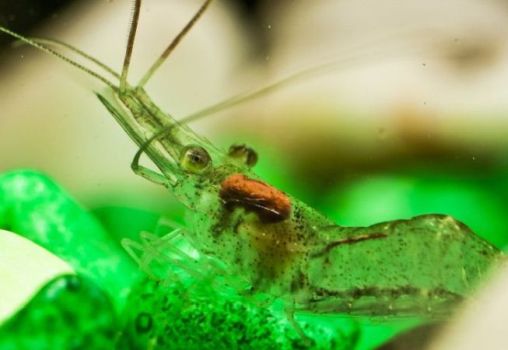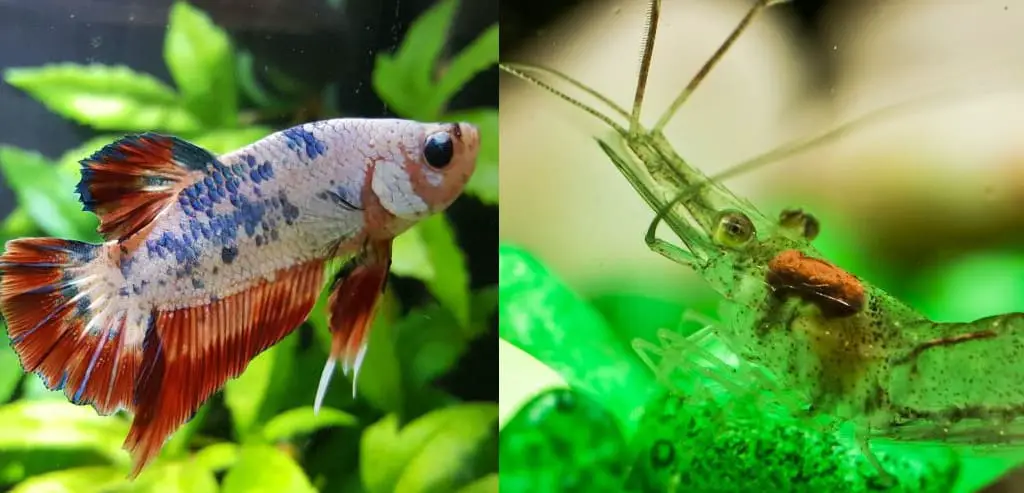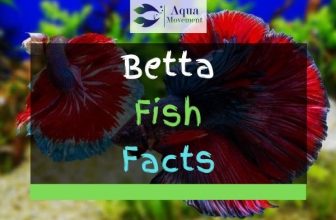Can Ghost Shrimp and Betta Fish Live Together?
Many aquarium enthusiasts will like their tank to have a healthy amount of variety and color. In many cases this involves mixing very different species of fish and shrimp, as well as aquatic plants or coral, and even ornaments like driftwood.
Of course, all of these separate elements might be very attractive and appealing in isolation, but as a responsible fish owner you have to consider whether these different fauna and flora will coexist happily together.
It is important to do thorough research before deciding to introduce any living creature to your tank, because they could throw the natural, harmonious balance of the tank out of whack.
In the worst-case scenarios, there could be outright aggression between inhabitants of the tank, or a predator prey dynamic may be established, and in an enclosed space the prey really has no chance!
Even if there is no obvious fighting or bullying go in your tank, mixing species could lead to increased stress in one or more of the inhabitants, or there could be a competition for resources.
Mixing species could also lead to the water conditions changing, which could have a detrimental effect on the long-term health and well-being of your pets. You must consider all these factors before deciding whether ghost shrimp and betta fish will work well together.
Table of Contents
Betta Fish

Betta fish are much sought after by hobbyists all over the world, because of their characteristic behavior and their dynamic, unique appearance. They are more commonly known as ‘Siamese fighting fish’, and there is a very good reason behind that name!
The fish is originally native to the countries of Indochina like Thailand, Cambodia and Vietnam, and mature adults can grow to a size of about 7 cm (2.8 inches).
Although they are naturally green or dull browned colored when found in the wild, in aquarium circles they have been bred to display brilliantly vivid red and orange coloring.
Also, they have a wide variety of different fin arrangements. This can make them one of the most aesthetically pleasing and spectacular fish that you are likely to find in an aquarium.
The Fighting Fish
They are renowned for their aggressive behavior, which has been focused and honed by generations of domestic breeding. This is of course one of their most interesting characteristics and one of the reasons for their popularity, but it also can make choosing a suitable tank mate a real issue.
One of the most interesting facts about this species is that both male and female fish can display aggressive tendencies, but it is more common in males.
This has been selectively bred for ever since the introduction of this species into Europe at the end of the Nineteenth century.
In fact, gambling practices have even arisen around the martial prowess of this fish, which accounts for its reputation as a ‘fighting fish’.
Obviously, this is a fearsome fish which can be intensely territorial, so it can be a tough decision to allow any creature to inhabit a tank with it, especially one as outwardly frail as a ghost shrimp.
Nevertheless, there are a number of factors which make this a potentially solid tank companion.
Ghost Shrimp

Ghost shrimp are also known as glass shrimp and their scientific name is palaemonetes paludosus. They are an attractive and affable shrimp which are native to the states of the South eastern United states, close to the Appalachian Mountains.
They are a largely translucent shrimp, with the ability to manipulate the pigments in their skin so as to camouflage themselves from any predators. They are one of the most popular shrimp to be kept in freshwater aquariums all over the world.
Fully grown adults can reach about 1 inch in size, which is large enough that most well-tempered betta fish will not target them too much.
Like most types of shrimp they are omnivores and are truly opportunistic scavengers. They will gladly feast on scraps of fish food that fall to the bottom of the tank, or will eat from aquatic plants or even algae.
This can have a very beneficial effect on the ecosystem and may improve the overall health of your tank.
Ghost shrimp are a moderately sized shrimp. Although they are larger than some variants of shrimp, larger species such as Amano shrimp are available and may be more suitable for some circumstances.
Also, they have a relatively short lifespan, and under most circumstances you can expect them to live up to a year and a half at most. This may be good or bad depending on your personal circumstances.
It is important to give it a lot of thought before you place them in the same tank as a fearsome creature such as a Siamese fighting fish.
Can Ghost shrimp and Betta Fish live together?

This is the million-dollar question. Can a small and peaceable creature like a ghost shrimp really share a tank with such an aggressive and territorial fish as a betta? Well, the surprising answer is yes, under most circumstances.
Of course, this really depends on your individual tank. If you have a betta with a particularly nasty or aggressive temperament, then no shrimp or smaller fish will survive long in the same tank.
However, if your betta is more gentle and not so prone to confrontation then it is likely that the ghost shrimp and betta fish can easily cohabit. They will spend most of the time largely ignoring each other, and may even thrive in the same tank.
The ghost shrimp is a peaceable creature which is unlikely to threaten the supremacy of your betta. As a result, they are unlikely to strike out at it so long as there is no direct competition for resources. Most ghost shrimp will meekly submit to the betta, and therefore amicable relations can be achieved.
What environment do you need?
The environment is very important to keep both shrimp and fighting fish. This will ensure that all your tanks inhabitants are happy and healthy, and will even help to maintain a harmonious inter species relationship.
Ornaments or Rocks
One of the most important components of the environment for ghost shrimp and betta fish is the ornaments, rocks, or other such shelter that must be placed on the bottom of the tank.
This is very important so that the ghost shrimp can shelter themselves and hide themselves away. This will give them some extent of protection if the bigger betta decide to strike out. Also, this will help the shrimp feel much more safe and secure, and therefore it will have lower stress levels and be generally healthier.
Aquatic Plants
Another important consideration is the aquatic plants. Ideally you should choose aquatic plants that help to mimic or recreate the native environment of the betta. Also, as an added benefit, the loose foliage from the aquatic plants can provide a tasty snack for your ghost shrimp!
As natural scavengers ghost shrimp will provide for a lot of their own diet, but you cannot neglect them entirely. It is important that you feed them some dedicated sinking food to help make sure they get all their essential vitamins and minerals.
Water Conditions
For different aquatic creatures to coexist contently, they must survive well in the same water. Fortunately, when it comes to the ghost shrimp and betta fish, they have overlapping ranges when it comes to water pH, temperature, and other factors.
Water chemistry and ambient conditions can drastically affect the overall health and well-being of your fish and shrimp. If these conditions stray outside of the species preferred ranges then you will immediately notice changes in their behavior or health.
Alkalinity
pH is one of the most important factors to control in your tank. pH refers to the acidity or alkalinity of the water, and it can vary from 1 to 14. In neutral water the pH is 7, and many freshwater fish prefer neutral or slightly basic water.
Ghost shrimp have an optimum pH range from 7 to 8, which overlaps perfectly with the optimum pH for Siamese fighting fish, which is 7.
Temperature
Temperature can have an equally large effect on the health of your beloved fish. Both ghost shrimp and betta fish are native to warmer freshwater shallows, so it is no surprise that they can coexist happily.
Ghost shrimp are relatively hardy and can survive over a broad range of temperatures from 72 to 84 F. Again, this is ideal for betta who like water at a constant temperature of around 78 F.
Other Water Conditions
It is the same story for other water chemistry parameters. For example, both ghost shrimp and betta fish like soft water with relatively low concentrations of dissolved minerals, while they also like low salinity conditions.
All these conditions mean that the ghost shrimp can make a perfect tank mate for the betta, so long as their temper is kept in check.
Tips and Tricks for Keeping Ghost Shrimp and Betta Fish
If you do plan on keeping ghost shrimp and Siamese fighting fish together, then there are a number of hints and tricks to help keep the peace in your tank.
First of all, proper feeding is key.
Not only does this make sure that your betta get all their required protein, vitamins and minerals, but it means they won’t start to look on your shrimp as tasty snacks. In general, betta will only attack larger shrimp like ghost shrimp in desperation or when they are in direct competition for resources.
So, if you feed your fish the required amount, two or three times a day, then you should have no issue with them attacking the shrimp out of hunger.
Tank Size
Also you must make sure your tank is of sufficient size. In general betta are used to rather congested conditions from their native waters in Asian paddy fields, and they do not have a need for high levels of dissolved oxygen, but this does not mean that you can keep them in an arbitrarily small tank.
The tank should be at least 10 gallons in size, although it should be larger if possible. Larger tanks will mean betta may be less territorial, more secure, and less aggressive.
Shrimp Population
Finally, you should be aware that ghost shrimp are prodigious breeders. They will give birth to many offspring, and their populations may rise out of control if you’re not careful. If that happen your betta will suffer, feel threatened, and will lash out.
In general, you should start with a small number of shrimp and gradually add more. Consider adding 3 or 4 at a time. This will prevent them from feeling isolated, but at the same time will prevent over breeding and rapid, unchecked population growth.
You should allow no more than 20 shrimp to occupy the same tank as one betta, otherwise the ecosystem may come under pressure.
Alternatives
In some rare cases, ghost shrimp might not be the best companion creature for your betta.
For more ill-tempered fish, you should consider Amano shrimp. These shrimp, originating in Asia, are larger and stronger, often growing up to 2 inches in size.
This is likely to deter any attacks from betta. They also have a longer lifespan (up to three years) and are even better at consuming algae hence helping to keep your tank clean and clear.
They are a wonderful alternative to ghost shrimp if you’re worried about your shrimp’s safety.
Conclusion
Betta are some of the most coveted aquarium fish in the world. Unfortunately, one of the main reasons for their popularity i.e. their aggression, is also the reason why it is hard to choose suitable tank mates for them.
You must carefully consider any species that are going to share a tank with these fiercely territorial creatures. Ghost shrimp are one of the most suitable species of shrimp.
They are large enough in size to look after themselves, they thrive in the same water conditions as betta fish, and they are easy to breed if you do lose some of them.
You should take precautions when introducing these creatures, and make sure that your fish are well fed, have sufficient space, and that there is plenty of suitable hiding spaces for the peaceable shrimp.




